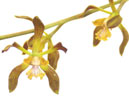|
|
|
|
 |
Email Address Recovery or Password Reset |
Use our Change Password page, and you can set a new password, or if you don't remember which email address you
registered with, the same page may be able to suggest it based on another you enter.
|
|
|
|
|
| |
Flasks of
Encyclia parviflora 'MC2213' × self |
|
| |
|
|
| |
| Number: |
TN3897 |
| Name: |
Encyclia parviflora 'MC2213' × self
(Also commonly known as Encyclia alata var. parviflora)
|
| Type: |
self (What's that?) |
|
Seed Donor: |
Carol J. Watson
(Email: CJWatson@cox.net)
|
|
Click to Enlarge

Pod Parent Flowers |
|
|
|
| |
Culture Notes from Donor: Parent plant: The plant is grown mounted on a slab of oak bark in temperatures ranging from a minimum of 60°F in winter to a high of 100°F+ in the summer.
Comments: Previously known as Encyclia alata v. parviflora, Encyclia parviflora is native from Mexico to Nicaragua, growing epiphytically in warm to hot tropical dry forests, and sometimes terrestrially in sandy areas.
Parent plant: Medium-sized plant.
For additional origin/habitat information supplied courtesy of
Charles and Margaret Baker, see further below, near the bottom of this page.
|
Temperatures we attempt to use in the lab & greenhouse:
| For Species: |
|
Spring, Summer, Autumn: days average 81°F, nights 68°F; best fit is Warm-Intermediate 87-64°F
(Source:
Baker's Web OSC) |
| For Species: |
|
Winter: days average 72°F, nights 61°F; best fit is Cool-Intermediate 75-58°F
(Source:
Baker's Web OSC) |
|
About the name...
| Etymology of |
Encyclia |
|
From Greek "enkyklein" to surround, in reference to the lip enclosing the column.
(Source:
Pridgeon 1992) |
| Etymology of |
parviflora |
|
From Latin "parviflorus" small-flowered.
(Source:
Mayr & Schmucker 1998) |
| Pronunciation of |
Encyclia |
|
en-SIK-lee-ah
(Source:
Pridgeon 1992) |
| Pronunciation of |
parviflora |
|
par-vi-FLOE-ra
(Source:
Hawkes 1978) |
|
If you would like to direct someone to this web page, please copy and paste this URL into your email:
http://troymeyers.com/d?013897
| Flask Information |
| Availability: |
Capsules failed. We were not able to make any flasks. |
| You should: |
Consider placing a "Notify Retries" Request, and if an identical pollination (the same parents) is done again, we'll let you know. |
|
You might also want to:
|
View items of the same species.
View items of the same genus.
|
| Ordering Information |
| You are not currently logged in. |
|
You must be a registered user and be logged in to reserve a flask or place a notification request. Please log in:
|
|
 |
Email Address Recovery or Password Reset |
Use our Change Password page, and you can set a new password, or if you don't remember which email address you
registered with, the same page may be able to suggest it based on another you enter.
|
|
|
|
|
|
|
|
| |
The origin/habitat information below is supplied courtesy of Charles and Margaret Baker
The following information is based on the name of the plant provided by the donor, and assumes that the name is correct. If the plant has been misidentified, then the following information may not be correct.
This text is copyrighted by the Bakers and may not be reproduced without permission.
ORIGIN/HABITAT: Mexico southward to Nicaragua. In Mexico, these orchids
are found along the eastern half of the country from the state of
Tamaulipas southward through San Luis Potosí, Puebla, Veracruz, Oaxaca,
and Yucatán, with distribution continuing southward to Nicaragua. Plants
grow in dry oak and mixed hardwood forests at 350-2600 ft. (100-800 m).
More about this information and the Bakers...
|
|
|
| |
|
|
|